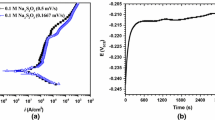Abstract
Chemical decontamination is accepted as one of the effective methods for decreasing radioactivity from radioactive materials existing in the systems of the nuclear power plants. In chemical decontamination processes, metal oxides dissolve in chelating agents such as oxalic acid and EDTA (Ethylenediaminetetraacetic acid) in the dissolution step for the chemical decontamination process. It is important to investigate corrosion behaviors with respect to decontaminating agents in the development of decontamination process. In this study, the potentiodynamic method was considered among electrochemical methods in order to investigate corrosion behaviors of stainless steels (SS 316, SS 304) and a nickel alloy (Inconel 600). The corrosion behaviors observed in the potentiodynamic results agreed with those of corrosion behaviors observed in the weight loss method, showing that the electrochemical study is a very useful method for estimating corrosion behavior.
Similar content being viewed by others
References
Ateya, B. G., Al Kharafi, F. M. and Abdalla, R. M.,“Electrochemical Behavior of Low Carbon Steel in Slightly Acidic Brines,”Materials Chemistry and Physics,78, 534 (2002).
Ayres, J. A.,“Decontamination of Nuclear Reactors and Equipment,” Ronald Press, New York (1970).
Bard, A. J. and Faulkner, L. R.,“Electrochemical Methods-Fundamentals and Applications,” John Wiley & Sons (1980).
Bayri, B., Rosset, R., Desbarres, J., Jardy, A., Noel, D., Kerrec, O. and Lantes, B.,“Complexing Properties of the Main Organic Acids Used in Decontamination Solutions for Nuclear Power Plants and Reactions Involved in Their Degradation or Elimination,”Nucl. Eng. Des.,160, 159 (1996).
Choi, J. H., Lee, H. J. and Moon, S. H.,“Effects of Electrolytes on the Transport Phenomena in a Cation-Exchange Membrane”J. Colloid Interf. Sci.,238, 188 (2001).
Dubourg, M.,“Hard Chemical Decontamination of Steam Generator Tube Bundles,”Nucl. Eng. Des.,159, 123 (1995).
Fontata, M. G.,“Corrosion Engineering,” 3rd ed., McGraw-Hill (1987).
Hur, D. H., Choi, M. S., Kim, U. C. and Han, J. H.,“Magnetite Dissolution and Corrosion Behavior in High Temperature EDTA Solvents,”Nucl. Eng. Des.,220, 11 (2003).
Jones, D. A.,“Principles and Prevention of Corrosion,” 2nd ed., Prentice Hall (1996).
Kim, K., Lee, H. J., Kang, D. W. and Inoue, S.,“Synthesis of Simulated Cruds for Development of Decontaminating Agents,”Nucl. Eng. Des.,223, 329 (2003a).
Kim, K., Lee, H. J., Choi, M., Kang, D. W. and Inoue, S.,“Establishment of an Optimal Decontamination Process on a Newly Designed Semi-Pilot Equipment,”Nucl. Eng. Des.,229, 91 (2004).
Kim, S. J., Okido, M. and Moon, K. M.,“An Electrochemical Studies of Cathodic Protection of Steel Used for Marine Structures,”Korean J. Chem. Eng.,20(3), 560 (2003b).
Kim, Y. S., Mitton, D. B. and Latanision, R M.,“Corrosion Resistance of Stainless Steels in Chloride Containing Supercritical Water Oxidation System,”Korean J. Chem. Eng.,17(1), 58 (2000).
Lee, H. J., Kang, D. W., Chi, J. and Lee, D. H.,“Degradation Kinetics of Recalcitrant Organic Compounds in a Decontamination Process with UV/H2O2 and UV/H2O/TiO2 Processes,”Korean J. Chem. Eng.,20(3), 503 (2003).
Lin, H. C., Lin, K. M., Lin, C. S. and Ouyang, T. M., “The Corrosion Behaviors of Fe-based Shape Memory Alloys,”Corrosion Science,44, 2013 (2002).
Moon, J. K., Byun, K. H., Park, S. Y. and Oh, W. Z.,“Dynamic Simulation of Cyclic Voltammogram on the Electrochemical Reduction of VO2 Ions,”Korean J. Chem. Eng.,14(6), 521 (1997).
Ocken, H.,“Decontamination Handbook,” EPRI Report TR-112352 (1999).
Omanovic, S. and Roscoe, S. G.,“Electrochemical Studies of the Adsorption Behavior of Bovine Serum Albumin on Stainless Steel,”Langmuir,15, 8315 (1999).
Park, K. S., Cho, M. H., Park, S. H., Sun, Y.K., Lee, Y S., Yoshida, M. and Nahm, K. S.,“Optimization of LiNiO2 Synthetic Condition and Effect of Excess Lithium and Al Doping on Electrochemical Characteristics of the Lithium Nickel Oxides,”Korean Chem. Eng. Res.,41(1), 68 (2003).
Rout, T. K., Jha, G., Singh, A. K., Bandyopadhyay N. and Mohanty, O. N., “Development of Conducting Polyaniline Coating: a Novel Approach to Superior Corrosion Resistance,”Surface of Coatings Technology,167, 16 (2003).
Sedriks, A. J.,“Stress Corrosion Cracking Test Methods,” NACE (National Association of Corrosion Engineers) (1990).
Siebert, O. W.,“Laboratory Electrochemical Test Methods. Laboratory Corrosion Tests and Standards,” ASTM STP 866, Haynes, G. S. and Baboian, R., eds., American Society for Testing and Materials (ASTM), Philadelphia (1985).
Tong, H. S.,“Corrosion and Electrochemical Behavior of Iron-Chromium-Nickel Alloys in Concentrated Sulfuric Acid Solutions, Electrochemical Corrosion Testing,” ASTM STP 727, Mansfield, F. and Bertocci, U., eds., American Society for Testing and Materials, Philadelphia (1984).
Varga, K., Hirschberg, G., Nemeth, Z., Myburg, G., Schunk, J. and Tilky, P.,“Accumulation of Radioactive Corrosion Products on Steel Surfaces of VVER-Type Nuclear Reactors, II.60Co,“J. Nucl. Mat.,298, 231 (2001).
Varrin, R. Jr.,“Characterization of PWR Steam Generator Deposits,” EPRI Report TR-106048 (1996).
Veawab, A. V., Tontiwachwuthikul, P. and Chakma, A.,“Investigation of Low-Toxic Corrosion Inhibitors for CO2 Separation Process Using Aqueous MEA Solvent,”Ind. Eng. Chem. Res.,40, 4771 (2001).
Wood, C. J. and Spalaris, C. N,“Sourcebook for Chemical Decontamination of Nuclear Power Plants,” EPRI Special Report NP-6433 (1989).
Yang, I. J., Teng, M. Y., Huan, W.I. and Sun, Y.L.,“Decontamination of the Reactor Coolant in Maanshan Nuclear Power Plant,”Nucl. Eng. Des.,167, 91 (1996).
Author information
Authors and Affiliations
Corresponding author
Rights and permissions
About this article
Cite this article
Lee, HJ., Kang, DW. & Lee, Y.J. An electrochemical study of stainless steels and a nickel alloy in a decontamination agent using the potentiodynamic method. Korean J. Chem. Eng. 21, 895–900 (2004). https://doi.org/10.1007/BF02705536
Received:
Accepted:
Issue Date:
DOI: https://doi.org/10.1007/BF02705536



